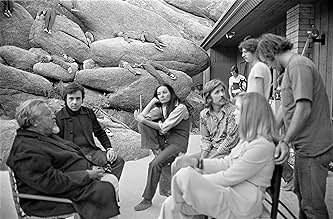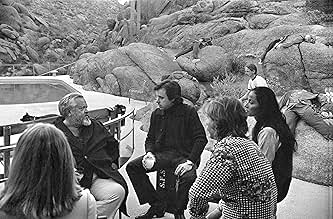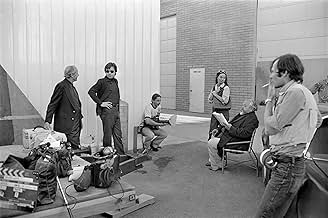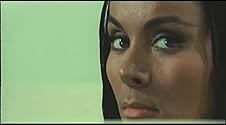VALUTAZIONE IMDb
6,7/10
8358
LA TUA VALUTAZIONE
Un regista di Hollywood emerge dal semi-esilio con l'intenzione di completare il lavoro su un film innovativo.Un regista di Hollywood emerge dal semi-esilio con l'intenzione di completare il lavoro su un film innovativo.Un regista di Hollywood emerge dal semi-esilio con l'intenzione di completare il lavoro su un film innovativo.
- Premi
- 9 vittorie e 8 candidature totali
Robert Random
- John Dale
- (as Bob Random)
Recensioni in evidenza
Some films are hard to judge, especially something like this, that may be very close to what Welles intended, but never finished and never really seemed to be really satisfied with (see also the documentary about Welles from 2018, which is really good). Now there are things in here that may seem redundant to some or annoying. Or even pretentious to some extend. If that rings true to you or not, it doesn't mean you are right or wrong, one way or the other. It just means you have feeling and maybe knowledge and that's why you lean to a particular way or side.
Having written all that, I am surprised by the amount of nudity that made it into the film. I'm also surprised about the film depicting scenes being shot "in real time" with off commentaries by the director, with different cameras, cuts and all that. Now obviously we are taking creative liberties here and it's supposed to be heightened. It's to prove a point or even points. So in a way there is more to the film than meets the eye. You have to approach this movie with a certain mindset.
If you do that, you may be able to see more than some others. But if you don't you'll probably be bored. Whatever your stance on this is and it will be dividing, you cannot call this an easy movie to watch. Some probably will watch it multiple times and cherish it's commentary and behind the scenes insights as much as its psychology. Others will just sneer at the mention of the title. In a way I'd say that would make Welles happy after all ...
Having written all that, I am surprised by the amount of nudity that made it into the film. I'm also surprised about the film depicting scenes being shot "in real time" with off commentaries by the director, with different cameras, cuts and all that. Now obviously we are taking creative liberties here and it's supposed to be heightened. It's to prove a point or even points. So in a way there is more to the film than meets the eye. You have to approach this movie with a certain mindset.
If you do that, you may be able to see more than some others. But if you don't you'll probably be bored. Whatever your stance on this is and it will be dividing, you cannot call this an easy movie to watch. Some probably will watch it multiple times and cherish it's commentary and behind the scenes insights as much as its psychology. Others will just sneer at the mention of the title. In a way I'd say that would make Welles happy after all ...
A famed, and infamous, movie director, JJ Hannaford, dies in a car accident. He was about to release his latest movie and a documentary camera crew had been following him around in the days preceding his death. We see the events leading up to his death, the careers Hannaford destroyed, the enemies he made and his last film, The Other Side of the Wind.
Written and directed by the great Orson Welles, this movie has taken nearly 50 years to be released. Welles started shooting it in 1970 and by his death in 1985 it had not been released. Production issues and politics prevented this. Now, in 2018, Netflix has released it. Being a huge fan of Orson Welles, the thought of seeing his long-dormant final film released was an exciting one.
However, the final product is quite disappointing. It looks and feels unfinished, a mashup of random scenes. While watching I thought that this was due to the film being in an unedited state when Welles died and it was edited to the final version after his death. Turns out the final version had already been edited by Welles, so we can't blame Netflix's production team.
The film-within-a-film element was initially intriguing but is ultimately confusing. What is part of Hannaford's film and what is Welles's film? Are the pretentious, trippy, hippy sequences and the gratuitous nudity and sex scenes Welles trying to appeal to early-70s arty audiences or his take on the pretentiousness of modern movies?
I would like to think that one of the themes of the movie is the pretentiousness of Hollywood, so will give Welles the benefit of the doubt on the content. However, it does become a jarring, disconcerting experience when you have seemingly-gratuitous scenes like those thrown randomly into the movie.
This said, it is not all bad. Welles's take on Hollywood, its movies and the pretentiousness of the times is well directed (if, indeed, that was his aim. It's so difficult to tell). The mystery surrounding John Dale adds intrigue. The story of JJ Hannaford is interesting and John Huston is perfect in the role. He pretty much just had to play himself!
Even here, however, Welles overeggs the pudding. I would have been more engaged in the Hannaford story if there weren't so many scenes that added nothing to plot or character development. So many scenes that just take up space and so much long, pointless dialogue. There's no momentum to the movie at all and the ending is a damp squib.
Written and directed by the great Orson Welles, this movie has taken nearly 50 years to be released. Welles started shooting it in 1970 and by his death in 1985 it had not been released. Production issues and politics prevented this. Now, in 2018, Netflix has released it. Being a huge fan of Orson Welles, the thought of seeing his long-dormant final film released was an exciting one.
However, the final product is quite disappointing. It looks and feels unfinished, a mashup of random scenes. While watching I thought that this was due to the film being in an unedited state when Welles died and it was edited to the final version after his death. Turns out the final version had already been edited by Welles, so we can't blame Netflix's production team.
The film-within-a-film element was initially intriguing but is ultimately confusing. What is part of Hannaford's film and what is Welles's film? Are the pretentious, trippy, hippy sequences and the gratuitous nudity and sex scenes Welles trying to appeal to early-70s arty audiences or his take on the pretentiousness of modern movies?
I would like to think that one of the themes of the movie is the pretentiousness of Hollywood, so will give Welles the benefit of the doubt on the content. However, it does become a jarring, disconcerting experience when you have seemingly-gratuitous scenes like those thrown randomly into the movie.
This said, it is not all bad. Welles's take on Hollywood, its movies and the pretentiousness of the times is well directed (if, indeed, that was his aim. It's so difficult to tell). The mystery surrounding John Dale adds intrigue. The story of JJ Hannaford is interesting and John Huston is perfect in the role. He pretty much just had to play himself!
Even here, however, Welles overeggs the pudding. I would have been more engaged in the Hannaford story if there weren't so many scenes that added nothing to plot or character development. So many scenes that just take up space and so much long, pointless dialogue. There's no momentum to the movie at all and the ending is a damp squib.
Other reviews have shed light on the challenges and controversy surrounding the creation of this film, so I will not cover that. The initial scenes are haphazard, but after a short while, the plot adopts a firmer grasp. Some scenes were shot in b/w, and other in color, and the mix of the various film stocks does work, for the most part. Shrewd, biting humor infuse the entire film, which skewers the Hollywood studio system and offers glimpses of hangers-on, while highlighting the sordid nature of fame.
Wonderful cast, with standout performances from Huston and Foster. Some of the the dialogue appeared improvised, and the energy was highly-charged. The upbeat jazz score by Michel Legrand was terrific. Overall, I enjoyed this wild ride. Even so, I wonder what would have happened if Welles would have had the funds to personally helm this film into full fruition? Did he genuinely intend for this film to be finished by someone else? What would have happened if it had been retained as a lengthy, experimental journey?
Wonderful cast, with standout performances from Huston and Foster. Some of the the dialogue appeared improvised, and the energy was highly-charged. The upbeat jazz score by Michel Legrand was terrific. Overall, I enjoyed this wild ride. Even so, I wonder what would have happened if Welles would have had the funds to personally helm this film into full fruition? Did he genuinely intend for this film to be finished by someone else? What would have happened if it had been retained as a lengthy, experimental journey?
I had the privilege of seeing this at the New York Film Festival. A sense of awe descended upon the audience as soon as the opening credits began. The fact that this film was finally completed and released is a triumph in and of itself.
Orson Welles' final film is chaotic and unwieldy, but also very haunting and melancholy. The soundtrack is amazing. There is frankly a sliver of a plot. An aging director attempts to make a comeback as Hollywood has drifted away from his era as he throws a big birthday party in which journalists, critics, admirers and some industry professionals join to celebrate. It soon becomes apparent that reporters are there to ascertain information about more than his work. His new film that is in the works is shown. We get to see an unfinished film within a film that is titled "The Other Side of the Wind", one that is sexually explicit.
The late John Huston portrays Jake Hannaford, the director whose approach to filmmaking has earned him a great following and his relationships with the actors he works with makes him a lightning rod of controversy. Huston's sepulchral voice and domineering presence make him flawless in the role as Hannaford. Peter Bogdanovich is well utilized as a younger, successful director whom Hannaford has taken under his wing but whom now Hannaford consults on how to better reach audiences of the new era.
This film is not flawless. The experience of seeing this at long last outweighs its drawbacks. There are some parts of this film that drag a bit. But there are also many, many scenes that are just astounding and I'm so happy they were finally brought to the big screen. Although this film is inconsistent in its narrative thrust, it returns very quickly to its busy, slightly manic state. I don't know if Welles deliberately left this unfinished. What I can say is that the editing is superb and provides us with a film that is a lasting testament to Welles and his legacy as a filmmaker. Highly recommended.
Orson Welles' final film is chaotic and unwieldy, but also very haunting and melancholy. The soundtrack is amazing. There is frankly a sliver of a plot. An aging director attempts to make a comeback as Hollywood has drifted away from his era as he throws a big birthday party in which journalists, critics, admirers and some industry professionals join to celebrate. It soon becomes apparent that reporters are there to ascertain information about more than his work. His new film that is in the works is shown. We get to see an unfinished film within a film that is titled "The Other Side of the Wind", one that is sexually explicit.
The late John Huston portrays Jake Hannaford, the director whose approach to filmmaking has earned him a great following and his relationships with the actors he works with makes him a lightning rod of controversy. Huston's sepulchral voice and domineering presence make him flawless in the role as Hannaford. Peter Bogdanovich is well utilized as a younger, successful director whom Hannaford has taken under his wing but whom now Hannaford consults on how to better reach audiences of the new era.
This film is not flawless. The experience of seeing this at long last outweighs its drawbacks. There are some parts of this film that drag a bit. But there are also many, many scenes that are just astounding and I'm so happy they were finally brought to the big screen. Although this film is inconsistent in its narrative thrust, it returns very quickly to its busy, slightly manic state. I don't know if Welles deliberately left this unfinished. What I can say is that the editing is superb and provides us with a film that is a lasting testament to Welles and his legacy as a filmmaker. Highly recommended.
Here it is, if anybody wants to see it.
Were you compelled by the character study of Citizen Kane? Were you thrilled by Touch of Evil? Then get ready for something unlike any of those or unlike anything. This is the mockumentary before Reiner or Guest, the improvisational dramedy before Apatow.
The entire point of this movie is that there's no point to this movie. Here is Orson Welles's most talked about movie about talking about a movie. His film about a film within a film. Orson Welles deliberately subverts Orson Welles to make an art film contained within an art film making fun of art films. John Huston plays John Huston playing Orson Welles as Orson Welles. Peter Bogdanovich plays himself as his own ripoff. There's a party celebrating a celebrated filmmaker making a film making fun of filmmakers. Nothing happens. So much happens. We learn everything about a legendary director about whom we learn nothing.
This film is a glimpse into the psyche of a filmmaker who wants to make films but has no idea how to keep making films. He wants to be commercially successful without compromising his integrity. He wants to make personal films for an impersonal audience. He wants to make something sexy despite being prudish. This movie isn't really for anyone; this movie is really for everyone.
It wasn't until the end of his life that Orson Welles realized the most important story he needed to tell was his own. It's a story whose only concern is that it was told, whether or not you like it. So watch it. Or don't. This movie doesn't care either way.
And if this review left you feeling confused, then I gave you an accurate impression of the film.
Were you compelled by the character study of Citizen Kane? Were you thrilled by Touch of Evil? Then get ready for something unlike any of those or unlike anything. This is the mockumentary before Reiner or Guest, the improvisational dramedy before Apatow.
The entire point of this movie is that there's no point to this movie. Here is Orson Welles's most talked about movie about talking about a movie. His film about a film within a film. Orson Welles deliberately subverts Orson Welles to make an art film contained within an art film making fun of art films. John Huston plays John Huston playing Orson Welles as Orson Welles. Peter Bogdanovich plays himself as his own ripoff. There's a party celebrating a celebrated filmmaker making a film making fun of filmmakers. Nothing happens. So much happens. We learn everything about a legendary director about whom we learn nothing.
This film is a glimpse into the psyche of a filmmaker who wants to make films but has no idea how to keep making films. He wants to be commercially successful without compromising his integrity. He wants to make personal films for an impersonal audience. He wants to make something sexy despite being prudish. This movie isn't really for anyone; this movie is really for everyone.
It wasn't until the end of his life that Orson Welles realized the most important story he needed to tell was his own. It's a story whose only concern is that it was told, whether or not you like it. So watch it. Or don't. This movie doesn't care either way.
And if this review left you feeling confused, then I gave you an accurate impression of the film.
Lo sapevi?
- QuizThe movie was filmed between 1970 and 1976, with editing continuing into the 1980s. When he died in October 1985, Welles left behind nearly 100 hours of footage and a work print consisting of assemblies and a few edited scenes.
- BlooperIn one confrontational scene, Brooks Otterlake, who Gregory Sierra's character, Jack Simon, refers to as, "Kid", is simultaneously Peter Bogdanovich and Rich Little. This is small overlap is because Rich Little was originally cast as the black turtleneck wearing, voice imitating director, Brooks Otterlake. However Bogdanovich replaced him, and Little's part was reduced to that of a Party Guest.
- Citazioni
[last lines]
Jake Hannaford: Who knows, maybe you can stare too hard at something, huh? Drain out the virtue, suck out the living juice. You shoot the great places and the pretty people... All those girls and boys. Shoot 'em dead.
- Curiosità sui creditiAfter the end credits, Hannaford's voice is heard saying "Cut"
- ConnessioniFeatured in AFI Life Achievement Award: A Tribute to Orson Welles (1975)
- Colonne sonoreLes Délinquants
Written and performed by Michel Legrand
Published by WB Music Corp. o/b/o Productions,
Michel Legrand + Editions Royalty
Courtesy of Decca Records France
Under license from Universal Music Enterprises
I più visti
Accedi per valutare e creare un elenco di titoli salvati per ottenere consigli personalizzati
- How long is The Other Side of the Wind?Powered by Alexa
Dettagli
- Data di uscita
- Paesi di origine
- Sito ufficiale
- Lingue
- Celebre anche come
- The Other Side of the Wind
- Luoghi delle riprese
- Aziende produttrici
- Vedi altri crediti dell’azienda su IMDbPro
- Tempo di esecuzione
- 2h 2min(122 min)
- Colore
- Mix di suoni
Contribuisci a questa pagina
Suggerisci una modifica o aggiungi i contenuti mancanti





































